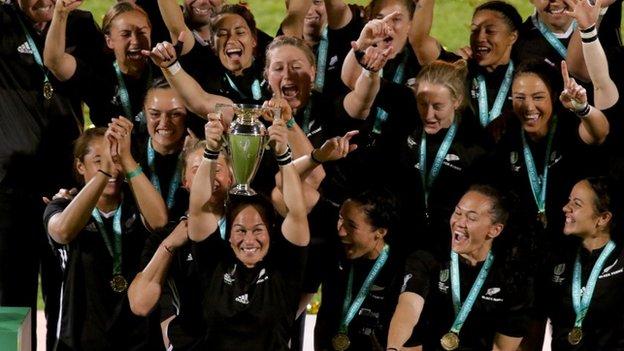
Women's rugby is still one of the "top three priorities" for World Rugby, says the governing body's general manager for the women's game.
Katie Sadleir says the commitment remains despite the coronavirus pandemic putting a strain on finances.
Sadleir told BBC Radio 4's Today programme "it is the strategic growth area of the game" - with participation up 28% year on year.
"We're pushing normalising women's rugby on and off the field," she said.
"I've been talking a lot about the impact of Covid and the challenges, and we're in a really unique situation. 2021 will be an amazing opportunity."
With the Olympics delayed until the summer of 2021 there will only be seven weeks between the women's Olympic Sevens tournament and the Rugby World Cup in New Zealand.
Sadleir describes both as "pinnacle events" that present an "amazing opportunity to really lift the profile of women's rugby".
She hopes to "drive participation growth and get the game back on as quickly as possible".
While many unions have talked about a return-to-play structure for their professional domestic men's leagues, there has been less published and discussed about the women's game returning.
Wellington player Alice Soper criticised the New Zealand rugby authorities for a lack of information - saying the "silence is deafening".
The NZRU then released a statement outlining their hopes for the resumption of women's rugby and said it "continues to be at the forefront of all our planning".
Sadleir did not comment directly on Soper's criticism, but did say: "We're working with our unions to make sure that they get back on track and support their women's programmes as quickly as is possible."
Part of the World Rugby commitment to women's rugby has been the launch of a new women's rugby coaching toolkit in help increase female coaching numbers.
It has set a target of 40% of women's coaches at the 2025 Rugby World Cup.
"This resource looks at some of the challenges, some of the opportunities, some of the unconscious bias, because women don't necessarily have the same networks," says Sadleir.
"But it really provides good best practice examples of how unions around the world have addressed those challenges, and give some tips on what people can do to change the current make-up of their coaching workforce."















 Phone: (800) 737. 6040
Phone: (800) 737. 6040 Fax: (800) 825 5558
Fax: (800) 825 5558 Website:
Website:  Email:
Email: 






